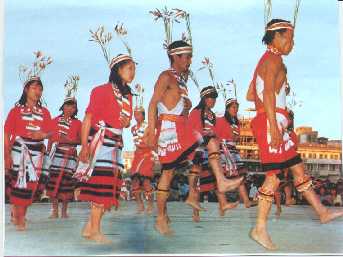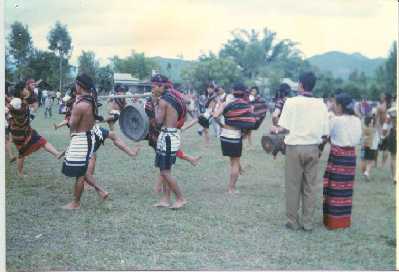
The TangKhul Dance

The KabuiNaga Dance
|
|
We are to examine
the status of primitive religion, not religion as such. Religion poses no
problem to the tribals of Manipur, who have increasingly become Christians,
keeping links with a world heritage. But we address ourselves to this question:
Are the tribal religions of North-East India going to be swept off from
the face of Earth? The anthropological distinction between the savage and
the civilized, the tribes and non-tribes (quite a problem in india) has
added confusion to the proper prospective of the issue. An indian anthropologist,
while equating religion ( for the primitive) with science for solving the
practical problems of life has gone to the length of making an absurd statement
that 'it lies with the future to show whether religion or science will
the race to secure real happiness for man' (Tarak Chandra Das:The Cultural
Heritage of India Vol. III,1937). Religion is eternal while religion
changes. The history of human civilization has now come to a point when
man starts expressing religion in depth in terms of spirituality when even
approximates to the latest finding of modern science. There i basic identity
of human religious urge, the sameness of the religious urge all over the
world and the inherent desire to be at peace with one's surroundings. Even
the most primitive religion is designed to noble life. It is only the mistaken
notion of what constitutes true nobility that drags the primitive down.
|
There are 29 scheduled tribes in Manipur, broadly classified into the Nagas and Kukis, a concept which is no longer operative. The Major tribes are Kabui ( now a composite group under the style of Zeliangrong) Mao and Tangkhul under the Naga group and Paite,Kom,Hmar,Vaiphei,Thadou,Gante and Zou belonging broadly to the Kuki group. It is a fashion to call their religions animistic with a belief in spirits and deities, which does not mean much and even amounts to a distortion of the proper prospective, depriving us of the meaning of symbolism associated with such religions. This so called specific outlook fails to recognise the existence of various worlds(14 lokas, after the Vedic tradition), and their constant and mutual interconnection. All these religions have their distinctive perception of the nature of the soul(or sometimes multiple souls),and of the Dead,doctrine of Karma, Supreme Deity and Gods and spirits including ancestor spirits and tutelary deities of the village etc. It is extremely difficult to understand these primitive religions in their authenticity as modern practical mentality shall undoubtedly color the interpretation. At the most we can have a superficial understanding of it.
The Kabuis believe in a multiple of Gods and Goddesses,
local deities and spirits and also in a Supreme God, Ra-Gang (King
of Gods) whose abode is in Heaven and who is immortal and eternal. They
have got their priests(whom they call Molls), and other diviners
of various attainments, The Tangkhuls worship a number of deities and are
fond if songs for all their activities- religious and secular. The Mao
Nagas conceive of Soul as 'The minute replica of the individual' which
us shared also by the Thadou Kukis and other Naga tribes, Blood sacrifice
is the main means of propitiation and exorcism in the case of the Paities
who believes in spirits- both good and evil, They have priests and other
siprit-media and believe in existence after death, with the spirits on
the way to Pailgal, guarded by a female spirit(sahnu).
The Koms believe in spirits and other natural forces and also in ancestor
worship. To the Koms, the comb is considered sacred. The Hmars believe
in a supreme Deity called Pathien (creator of all beings), and worship
the spirits - good and evil- of the mountains, the rock and the rivers.
The belief in a Supreme God is also shared by the Thadous who have also
the concept of heaven and hell. They have also the deity of the house called
Indoi (a counterpart of the Meitei Sanamahi having a larger
connotation). The Koms have also Iuroi ,a household god. They
also believe in two deities viz., Pathien(Supreme God), and his
brother Lungiei, both of whom live in heaven. The Vaipheis also
believe in Pathein and Indoi as the guardian spirit
of every household, besides the various spirits who are equally worshipped
and feared. The Chakpa communities of the valley of Manipur,located at
such places as Shekmai, Phayeng,Leimaram and Andro ( called scheduled castes),
believe in the sky-god and other sipirits, as manifested in their distinctive
Lai Haraoba festivals. They still take wine and meat, unlike the
Vaishnava counterpart and are supposed to preserve traditional culture
of the Manipuris.

|
It is evident that the core primitive religion as reflected in the life-style of the people of the hills of Manipur is the belief in magic and ancestor-cum-deities and other spirits pervading the village. It represents the manifestation of religion in various phases of culture and civilization, indicating the origin of the magico-religious cults of the later Tantrikas associated the tantrik belts of North-East India which extends on the authority of Dr. S.B. Das Gupta, from Tibet,Nepal, Bhutan to Assam and other parts of North-East India and Bengal. The Tantrik elements traceable in Mohenjodaro civilization have created an impact on the culture of the Manipur valley for more than 500 years. |
It is also possible that the hill people have forgotten the symbolism of the ancient and stuck to conventional forms of religion, having lost the sense of communion with the various deities. Only a few priests and priestesses preserve this tradition with some occult powers which are often utilized for non-spiritual and egoistic purposes.
Christianity came to Manipur in the early part of the 20th century. The American Baptist Mission Society was allowed to work among the Tangkhuls of Ukhrul district as early as 1896. Twelve young men were first baptized in 1901 by Rev.W.Pettigrew. It was followed by the opening of other centers and arrival of other missionary groups in various areas of the hills of Manipur. Roman Catholic Mission also joined the movement a little later and is now associated with the starting of various schools all over the valley and the hills. More than 70 percent of the entire population in the hills have now adopted Christianity. The British system of education along with the modernization process have now opened the eye of the educated old and young men to the world of science and the spirit of inquiry and investigation. The non-christians specially the Kabuis, reacted also to the impact of Hinduism of the valley, knowingly or unknowingly. In the later twenties, came up a Kabui mystic Jadonang, a religious reformer, who made a plea for the construction of a temple for the Supreme Deity (Ragang) and his consort. This work was taken up by his associate,Rani Gaidillu, after he was executed on a murder charge in the hands of the British. Some of the valley Kabui adopt Lord Shiva, consult astrologers and offer Puja. The Purums talk about sanamahi (Meitei God) and Hindu Krishna as their God.
Sociologically speaking Christianity represents modernization among the tribals in various facets of their life and the change in their material culture is remarkable. Another significant force is urbanization with Imphal(the capital) and other urban centers for constant interaction among the people of the hills and the valley. The participation of the tribes in their political development along with other modernizing forces generated by mass media, the application of science and technology to their style of life is also responsible for their neglect of the primitive faiths. But all is not going to be lost. The sense of cultural identity ( a 20th century phenomenon) has affected the elites among them and they have become much more aware of their cultural roots which finds expression in organizing such major joint festivals like kut for the Kukis and 'seed sowing' for the Nagas organized annually on a state level. The tribals have now become proud of their cultural heritage, even though they cannot go back to the primitive religions. This is a it should be. The educated people of the hills being conscious of their proud heritage in human values(which V.Elvin discovered in NEFA, Now Arunachal) have to assimilate other modernist traits of the culture from a wide spectrum and march forward. There is no point in lamenting for old religions which have necessarily to go, of which the spiritual essence is bound to survive in the views of the people, consciously or unconsciously. The old religion survive in a new form and gets metamorphosed into a new style of life.
The march of human cycle indicates that we must adopt a futuristic outlook. We can go back to the Vedas but cannot live the Vedic symbolism. All religions, even the most advanced ones, are a little off-the color now. The future belongs to a creative synthesis of science and spirituality as Vinoba Bhave puts it. Says Mother of Sri Aurobindo Ashram : 'One must not confuse a religious teaching and a spiritual teaching. Religious teaching belongs to the past and stops all progress. Spiritual teaching is the teaching of the future. It enlightens the consciousness and prepares it for the future realization. A spiritual teaching is above religions and strives towards a total truth. It teaches us to come into direct contact with the Divine.' Primitive religions cannot be revived. But their culture may survive in a new form. Even the established religions have to undergo a metamorphosis into spirituality and is we are to trust Sri Aurobindo, we can wait for 'the advent and the progress of the spiritual age'.